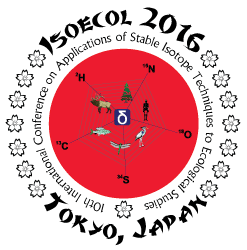Amino acid and radiocarbon insights from captive whale sharks
Alex S.J. WYATT1*, Rui Matsumoto2, Yoshito Chikaraishi3, Yosuke Miyari1, Yusuke Yokoyama1, Keiichi Sato2, Nao Ohkouchi3, Toshi Nagata1
1Atmosphere and Ocean Research Institute, The University of Tokyo, Kashiwa, Chiba, JAPAN
2Okinawa Churaumi Aquarium, Motobu, Okinawa, JAPAN
3Japan Agency for Marine-Earth Science and Technology, Yokosuka, JAPAN
*Presenting author
Stable isotope analyses (SIA) have the potential to provide novel insights into spatial and temporal patterns in the trophic ecology of poorly understood organisms like whale sharks Rhincodon typus. However, interpreting SIA depends on accurate diet-tissue discrimination factors (DTDF) to quantify diets and trophic positions, with experimental derivations of DTDF rare for such large-bodied organisms. Captive R. typus have provided a unique opportunity to validate a range of SIA, compound-specific isotope analyses (CSIA) and radioisotope approaches in the world’s largest fish and one of three planktivorous sharks. Diet records over the past five years revealed a diet dominated by North Pacific and Antarctic krill, 44% and 49% of weighted diet for Euphausia pacifica and E. superba, respectively. Despite the well-known diet, SIA of fin tissue from three captive R. typus (7.1, 7.2, and 8.4 m in length) proved hard to reconcile, especially for bulk carbon. In contrast, CSIA of amino acid (AA) nitrogen in the sharks’ tissue was relatively stable over time, despite evidence of variation in AA compositions and δ15N-AA of diet components. Tissue radiocarbon further suggested either long turnover in fin tissues (27 months), or the preferential assimilation of the smaller E. pacifica (Δ14C of 3 ‰ compared to -112 ‰ for E. superba). Daily-scale analysis of radiocarbon in R. typus faeces may support the preferential assimilation hypothesis, faeces generally being depleted relative to diet. Together, CSIA-AA and radiocarbon analyses add multiple addtional axes to our isotope space and may alleviate some of the complications involved in interpreting bulk SIA in ecological studies.

